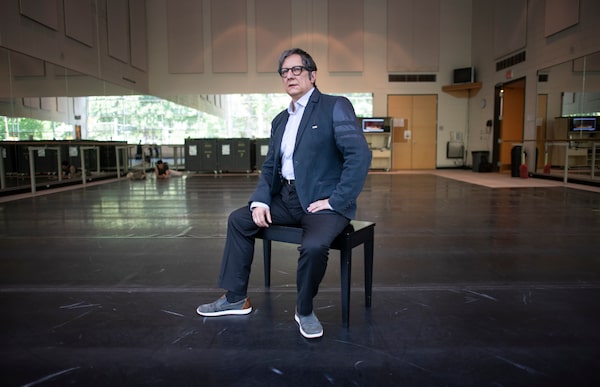
Theatre director Robert Lepage is photographed in a rehearsal studio at the Four Seasons Centre for the Performing Arts, on May 31.Fred Lum/The Globe and Mail
We have the CBC and the NHL to thank for Frame by Frame, the high-tech dance homage to Scottish-Canadian animation pioneer Norman McLaren from Robert Lepage and Guillaume Côté. The show, now in revival at the National Ballet of Canada, might never have come about if the public broadcaster hadn’t used McLaren’s films as filler during hockey playoffs.
“The game would be over and there’d be 15 minutes of airtime that CBC had to fill,” says Lepage, recalling his childhood in the Quebec City of the 1960s while settled on an office sofa in the National Ballet’s Walter Carsen Centre in Toronto.
“And it was always a Norman McLaren movie.” It might be the slapstick, anti-war Neighbours, which had won McLaren an Oscar. Or his film with another Oscar – Begone Dull Care, a sprightly animated response to improvisations by the jazz pianist Oscar Peterson.
In McLaren’s visual trickery and love of experiment, Lepage recognized a kindred spirit. When the famed stage director was ready to make his grand jeté, so to speak, into ballet, the animator was an obvious subject.
Even more so because McLaren himself adored ballet. Among the most celebrated shorts made during his legendary five-decade tenure at the National Film Board of Canada are Pas de deux, Narcissus and Ballet Adagio, which meld balletic grace with dreamlike special effects.
Although Lepage’s own theatre works are imbued with cinematic effects, in his words, “I know zilch about dance.” To create Frame by Frame, he found a perfect partner in the National Ballet’s Côté, a dancer-choreographer who combines serious classical chops with his own forays into filmmaking. “We have great trust and respect for each other,” Lepage says. “And we’re friends enough that we can laugh our heads off if something’s really bad.”
The pair originally premiered Frame by Frame in 2018. It was dazzling, but imperfect. Its remount this season was an opportunity to cut or rethink sequences that didn’t work, expand others that did, and add an intermission to its two-plus hours so the audience could catch its collective breath.
The original production and the remount were workshopped at Lepage’s fabled Ex Machina laboratory in Quebec City, where a crack team of designers and technicians help him conjure his stage magic. “You’re in this bubble of creativity,” Côté says, describing it in a separate interview. “Everyone in that building is over-the-top passionate about what they do. It’s incredibly inspiring.”
Lepage and Côté got the dancers – a cast of 28 – to contribute to the creative process, pitching ideas and shaping their roles. That type of collaboration is unusual for a ballet. “We wanted to see what their personality could bring to a character,” Lepage says. “They were shy at first, because they’re not used to working like that. But once they understand what they can bring to a role, the performances shine.”
McLaren is more than an artistic soulmate for Lepage. He also represents a period of wild creative ferment in 1960s Montreal, at the dawn of Quebec’s Quiet Revolution. By then, the Ottawa-born NFB had relocated to the city and McLaren was doing some of his most inspired work as head of its animation studio.
“The NFB went from being a federal institution to being part of this crazy, hippie, pot-smoking, Expo’67 scene, where everything was out in the open,” Lepage says. McLaren’s films drew on Montreal’s incredible arts community in collaborations with the likes of Peterson and the dancers of Les Grands Ballets Canadiens (three of whom – Anna Marie Holmes, Margaret Mercier and Vincent Warren – would later become Côté's teachers).
Lepage has returned to Frame by Frame having just opened a new theatre opus about another Canadian arts icon, painter Jean Paul Riopelle. His Projet Riopelle, commissioned for the 100th anniversary of the artist’s birth, is currently enjoying a run at Montreal’s Théâtre Jean-Duceppe, where it has been held over to June 11.

Lepage has just opened a new theatre opus about another Canadian painter Jean Paul Riopelle. Projet Riopelle, commissioned for the 100th anniversary of the artist’s birth, is currently enjoying a run at Montreal’s Théâtre Jean-Duceppe.Fred Lum/The Globe and Mail
The two shows dovetail neatly for Lepage. Riopelle was one of the Automatistes, the group of Québécois surrealists whose incendiary 1948 manifesto, Le Refus global (“total refusal”), spat in the eye of Quebec’s repressive, church-dominated and censorship-ridden Duplessis era. That manifesto is often cited with helping to ignite the Quiet Revolution.
“What pulls me into the stories of these artists is that it’s about who we are,” Lepage says. “My work is a lot about memory and going back into time and trying to understand how we got here. The Riopelle project is very much about who we are as Quebeckers, how we’ve evolved, culturally as well as artistically.”
Lepage himself experienced a push toward artistic evolution in the summer of 2018, when he became embroiled in a pair of controversies over cultural appropriation. First there was SLAV, a musical piece featuring the songs of Black slaves, co-created with white singer Betty Bonifassi, which drew protests and was cancelled mid-run at the Montreal International Jazz Festival. It was closely followed by the outcry over Kanata, his in-progress collaboration with France’s venerable Théâtre du Soleil about Canada’s Indigenous people, created without any Indigenous artists. The project was scrapped when one of its co-producers pulled out, although a revised section of it was performed in Paris at the end of 2018.
It was an unsettling experience for Lepage. At first defensive, he and his collaborators later met with their detractors and reached an understanding.
“There was a lot of naiveté on everybody’s part,” he says now. “We recognized our goofs and misjudgments. You’re under this illusion that, if you’re interested in somebody’s culture, you can tap into it. But we’ve realized that people who have been enslaved or colonized don’t want to be ripped off.”
Now 65, Lepage is a far cry from retirement. Among his many upcoming projects is a second collaboration with Côté, a dance-theatre piece based on Hamlet that will premiere with the choreographer’s own company, Côté Danse. He’s also mulling a pandemic-themed work, inspired by his accidentally coming across the gravesite of Gaëtan Dugas – the Air Canada flight attendant wrongly blamed for bringing AIDS to the United States in the 1980s – during a neighbourhood walk in Quebec City at the time of the COVID-19 curfews.
Then there’s his new job overseeing Le Diamant, his dream venue in Quebec City, which opened in 2019 as a home base for his globe-trotting Ex Machina shows. Its flexible 642-seat theatre also allows him to present other fare that shares his aesthetic. The programming is pure Lepage: avant-garde theatre, chamber operas, circus, even pro wrestling. “Anything that’s theatrical is invited,” he says.
Keep up to date with the weekly Nestruck on Theatre newsletter. Sign up today.